The Doomino Effect for Oct 22, 2008
I have 12 books in my stack this week. No lie.

 First up is Final Crisis #4, which is definitely my favorite issue of the series so far. This, of course, is relative to how awful I thought the first three issues were.
First up is Final Crisis #4, which is definitely my favorite issue of the series so far. This, of course, is relative to how awful I thought the first three issues were.
Back in college, I took a beginning screen writing class from a wannabe has-been, whose professional filmmaking experience was something like driving a van for universally panned low-budget indie films. Even he taught us “Show, don’t tell.” If you want something to resonate with an audience, showing it to them will make them believe it.
Morrison apologists have defended the decision to remove critical pieces of the story as a form of artistic experimentation, even comparing it to subtractive songwriting. Inherently, there’s nothing wrong with taking such an approach, and it can obviously lead to a rewarding reading experience. The key difference, of course, is that songs like “Raspberry Beret” are fantastic pop songs — they don’t have to be forgiven or defended based on their methods.
Though I end up switching places with reviewer Chris Miller, he’s absolutely correct in pointing out the problems that can arise when one chooses to remove critical points in the story.
It’s just that it has no emotional resonance. The narrative style relentlessly leaches the dramatic impact out of what it depicts. It skips around among seemingly unrelated scenes, often eliding important developments, showing effects but not causes, while shifting characters on and off stage seemingly at random… thus almost deliberately avoiding dramatic tension.
Previously, we were just being told about the threats to Earth, the multiverse, etc.: Evil won, or was winning, or the end was near or the end is here. Stuff like that. This time, we actually saw it. We see the hordes overrunning the cities; we see the heroes falling; we see a gnawed off Green Lantern arm; we witness Turpin’s struggle, and eventual failure, to resist Darkseid. We see Barry Allen’s calm confidence as some kind of anti-life cure. I also loved that part of the resistance movement included printing and distributing a newspaper — I actually think that tiny element made this whole struggle seem that much bigger.
Getting back to the point about the frustrations with the storytelling style, I doubt any Morrison apologist would argue this issue was weaker for including such moments. There’s still plenty I don’t know, plenty I don’t understand, and plenty I am hoping to figure out; none of that was damaged by giving me something to care about.
I also thought this issue included fewer of the frustrating dumb things from previous issues. Yes, the heroes are trying to evade the villains’ snooping by using the villains’ secret internet; Green Arrow’s whole purpose for staying behind at the Hall of Justice was to wreck the teleportation system, and he appeared to forget to do that. But for the first three months, I had nothing to write about but dumb things that jerked me out of the story.
The big problem I’m still having with this series is that I didn’t know which pre-Final Crisis continuity I’m supposed to accept and which I’m supposed to ignore. Orion’s third death in FC #1 made me think I was supposed to ignore Countdown and DONG, so I never really understood when Darkseid fell (in the Final Crisis version of events), or if it had anything to do with either Countdown or DONG and the reasons behind the death of the Fourth World. I didn’t know if I was supposed to remember those motivators (the Source did it!) and some of the outcomes (like Darkseid falling, but not Orion falling), or maybe just remember the motivators and not the outcomes, or just some of the outcomes and not the motivators, or neither. The fact that I don’t know what the mystery is doesn’t make me more intrigued.

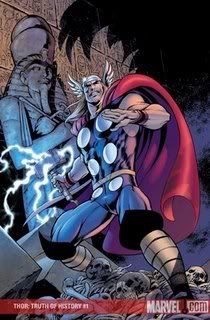 Speaking of mysteries and gods, that leads me to Thor: The Truth of History #1, a one-shot from Alan Davis. It’s about the history of the Sphinx.
Speaking of mysteries and gods, that leads me to Thor: The Truth of History #1, a one-shot from Alan Davis. It’s about the history of the Sphinx.
I’ve never been a Thor fan. I think I bought maybe an issue or two in the early ’90s when he had a beard. I bought one issue within the past few years as our Book of Doom, but I didn’t like it. But if Thor comics were like this on a regular basis, I’d totally read them.
I think what I liked best was that there was an acknowledgment of all kinds of different gods representing different cultures, and there were definitely good guys and bad guys, but there was an undercurrent of moral relativism that didn’t come off as preachy or judgmental. The Norse gods are just the Norse Gods, and they happen to live down the street from the Egyptian gods, some of whom are nice and some of whom are jerks, just like all the rest of the gods.
Thor, of course, is clearly a good guy, and he saves the day by imposing his own brand of lightningy justice, but it’s on individuals, not belief systems. None of this ancient religious respect had any kind of impact on the story, but I really liked it as a backdrop. Storywise, it was just a fun one-shot with fantastic Alan Davis / Mark Farmer art.


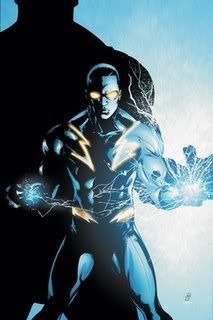 Speaking of one-shots, that leads me to Superman: New Krypton #1, which was this week’s Book of Doom, as well as Final Crisis: Submit, a chapter in the big Final Crisis story that comes directly before FC #4. I actually looked in the opening pages of both FC #4 and FC:Submit for any cues, like “Be sure to read XX first, and then come back and read this!” Nope. So I took my chances and read FC #4 first. Oops.
Speaking of one-shots, that leads me to Superman: New Krypton #1, which was this week’s Book of Doom, as well as Final Crisis: Submit, a chapter in the big Final Crisis story that comes directly before FC #4. I actually looked in the opening pages of both FC #4 and FC:Submit for any cues, like “Be sure to read XX first, and then come back and read this!” Nope. So I took my chances and read FC #4 first. Oops.
This is the story of how Black Lightning found the Tattooed Man, gave him the symbol he had in FC #4, and then fell victim to Anti-Life. Maybe there’s supposed to be a little parallel between the hate Darkseid spreads in the zombie masses and the hate that the Tattooed Man spreads in his family. Maybe. But it was a drawn out exercise in self-righteousness and stubbornness that I could’ve done without.

 Speaking of drawn out, that leads me to X-Factor #36, a book whose artist, Larry Stroman, has received much scorn from Fin Fang Doom and Doom DeLuise. Personally, I really like Stroman’s art, though I can totally see how people wouldn’t. By no means do I think Stroman is a “bad” artist — to say so would be to suggest that he’s attempting something and failing; I think it’s actually the complete opposite — he’s perfectly achieving what he’s attempting to do. It’s just not the right fit.
Speaking of drawn out, that leads me to X-Factor #36, a book whose artist, Larry Stroman, has received much scorn from Fin Fang Doom and Doom DeLuise. Personally, I really like Stroman’s art, though I can totally see how people wouldn’t. By no means do I think Stroman is a “bad” artist — to say so would be to suggest that he’s attempting something and failing; I think it’s actually the complete opposite — he’s perfectly achieving what he’s attempting to do. It’s just not the right fit.
Historically, putting Stroman on X-Factor with Peter David is kind of fun, as I loved their work together on the relaunch of the team in the early ’90s. Editorially, it was probably a pretty poor move, as the standout theme of this title in the past few years has been how un-superheroish and real-lifeish it is.
Stroman’s work is just not suited for that theme. I can only imagine how much better the drama of this story might’ve been conveyed by one of the more “realistic” artists Marvel’s been using on this book over the past three years. His style is very abstract and expressive. It was perfect for the ’90s X-Factor relaunch — essentially a parody of superhero teams like the original ’80s X-Factor. The exaggeration and motion helped carry the tone. While David is keeping a lot of the humor intact, he’s clearly taking the book in a different direction. It may be a variation on the superhero team, but it’s far from a parody.
Anyway, I stopped reading this book after the Arcade story, which I was excited by but then very disappointed with. I’m not sure how many issues I’ve missed, but Darwin’s with the team now and so is Longshot. I’m not a Longshot fan. I think his powers are stupid and so is his haircut.

 Speaking of stupid powers and things from X-Men past, that leads me to X-Men Legacy #217. I stopped reading this book after Messiah Complex. Apparently Professor X is struggling to remember a bunch of stuff about his past and Wolverine has a kid with a dumb mohawk and two claws. What’s the deal with Wolverine’s kids having two claws? Will their kids only have one, and then their kids will have none? Did Wolverine’s dad have four? Did Wolverine’s great-grandpa have six?
Speaking of stupid powers and things from X-Men past, that leads me to X-Men Legacy #217. I stopped reading this book after Messiah Complex. Apparently Professor X is struggling to remember a bunch of stuff about his past and Wolverine has a kid with a dumb mohawk and two claws. What’s the deal with Wolverine’s kids having two claws? Will their kids only have one, and then their kids will have none? Did Wolverine’s dad have four? Did Wolverine’s great-grandpa have six?
Anyway, the Hellfire Club is involved, and I’ve always thought the Hellfire Club was pretty sweet. I’m totally out of the loop, though, because I thought Sebastian Shaw got killed by the Upstarts in the early ’90s and I have no idea who Lady Mastermind is. I also have no interest whatsoever in reading Wolverine: Origins, where this story crosses over to, but there was just something about this that made me want to keep reading it. I don’t know if it was the sense of the bad guys having the upper hand, Wolverine walking into their trap, a big picture plot playing out, or creative retconning of X-history, but I dug it and will probably get back to reading this monthly. I’ve dropped Uncanny and Astonishing, so it might be kind of nice to buy one X book.
The art was good too, even in spite of Wolverine Junior’s mohawk. Lady Mastermind looks like she’s dressed to go to work in an office, though, which kind of cracks me up. Maybe she’s going for the Evil Sexy Secretary look.

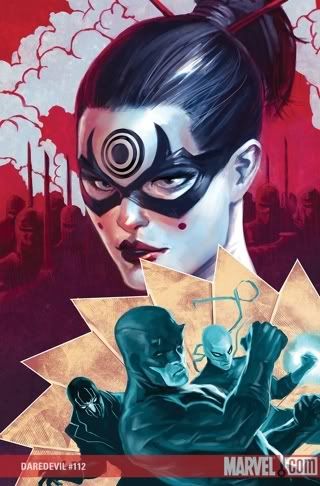 But speaking of villains that are knockoffs of established villains, only female and with “Lady” in front of their name, that leads me to Daredevil #112, part 2 of the Lady Bullseye storyline, also known as “The storyline that has gotten me excited about Daredevil again.”
But speaking of villains that are knockoffs of established villains, only female and with “Lady” in front of their name, that leads me to Daredevil #112, part 2 of the Lady Bullseye storyline, also known as “The storyline that has gotten me excited about Daredevil again.”
We find out that this is all about a power struggle within the Hand following the revelation that Elektra is a Skrull. I give Ed Brubaker credit for sort of keeping Daredevil in its own little pocket of the Marvel Universe but also playing on the events that happen elsewhere. It ends up making both this series and the greater Marvel U seem more important.
So Black Tarantula, Iron Fist, and — if I remember correctly from last issue — Wolverine are targets of the Hand. At this point, though, they’re all just being tested for whatever Lady Bullseye has in store. The three-page appearance of Danny Rand reminded me how bummed I was when Brubaker left Iron Fist. He just makes that character so cool.
The “true crime” aspects of modern Daredevil stories and the complications of Matt Murdock’s personal life are themes that have, at times, become a little tiresome for me, but this storyline is balancing them all extremely well. Matt’s boot-knocking with Dakota is his alibi for the murder Lady Bullseye framed him for. How perfect is that? And the issue ends with this Master Izo character snooping around in the fridge, looking for a beer after breaking into Murdock’s house, telling Matt they are going to “destroy The Hand.” Awesome.

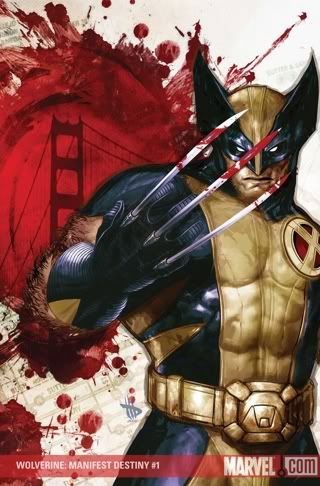 Speaking of those crazy Asians, that leads me to Wolverine: Manifest Destiny #1, which has Wolverine mixing up with the Chinese in San Francisco. Something to do with his past, of course.
Speaking of those crazy Asians, that leads me to Wolverine: Manifest Destiny #1, which has Wolverine mixing up with the Chinese in San Francisco. Something to do with his past, of course.
It appears that this series is existing solely for more self-loathing, drinking and fighting, in which case it has all the makings of a great Wolverine story. I don’t know anything about writer Jason Aaron or Stephen Segovia, but Segovia’s got himself a decent While Portacio / Leinil Yu knockoff style going on. I’d much rather see an artist develop his own style, but if you’re going to rip someone off, I’ll be easily won over by ripping off two of my favorites. John Rauch’s colors — confined largely to greens and oranges — are fantastic.

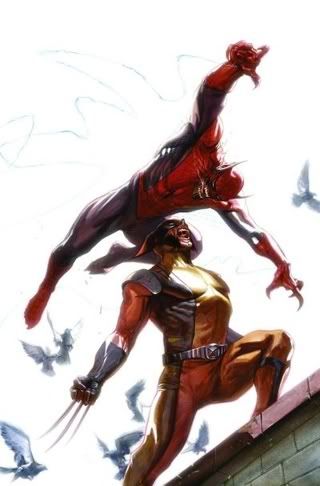 Speaking of Leinil Yu, that leads me to Secret Invasion #7, which is nothing but a whole bunch of fighting.
Speaking of Leinil Yu, that leads me to Secret Invasion #7, which is nothing but a whole bunch of fighting.
There are some nice little character moments that take the reader through the battle — the greeting of Nick Fury and Norman Osborn; Bullseye passing up a clean shot on Spider-Man in order to take down Skrull Pym; Skrull Pym being a Skrull and still continuing the post-marital bickering with Janet Wasp; Jessica Jones entering the battle; Noh-Varr accepting Mar-Vell’s role as Earth’s defender; Clint “Ronin” Barton picking up the fallen Hawkeye’s bow.
One thing I liked that this issue did, via the personal drama of humans versus Skrulls in the battle, was remind me of who is missing (Invisible Woman, Spider-Woman, Hank Pym, etc.) and make me wonder what happened to them and when we’re going to find out. It was one of the original charms of the whole Skrull invasion concept, and I think it had been lost a bit in recent months.
I’d been losing faith and interest in this series, because I think it has dragged out too long, but I like how the stage is set for the final chapter — the Queen is dead, Jarvis Skrull has Baby Cage, and something bad is happening to Janet van Dyne. Judging from the comments of the Pym Skrull, it looks like he made her some kind of unwilling human bomb when he gave her that new “Growth formula” gift back in Mighty Avengers several months back. It’d sure be a bummer if she went and blew up.

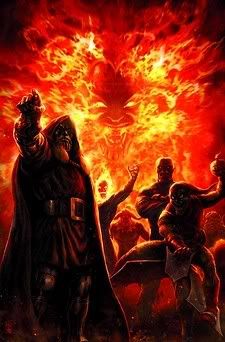 Speaking of Secret Invasion, pardon me for the lazy segue, but that leads me to New Avengers #46. I’ve been moaning for months about how the Avengers titles used to be must-reads and then became completely worthless, but this one was good. It’s about how the Hood’s clique of villains sniffs out the Skrulls in their ranks, and this issue reveals that the Hood can actually see through the Skrull disguise with his powers. We also finally learn that Dormammu is the demon behind the Hood’s powers.
Speaking of Secret Invasion, pardon me for the lazy segue, but that leads me to New Avengers #46. I’ve been moaning for months about how the Avengers titles used to be must-reads and then became completely worthless, but this one was good. It’s about how the Hood’s clique of villains sniffs out the Skrulls in their ranks, and this issue reveals that the Hood can actually see through the Skrull disguise with his powers. We also finally learn that Dormammu is the demon behind the Hood’s powers.
This whole rise of the Hood has been a fun thread in New Avengers, and I can only assume it’s going to lead in to whatever happens after Secret Invasion. Good for Marvel for laying this groundwork years in advance. And Billy Tan is pretty awful.

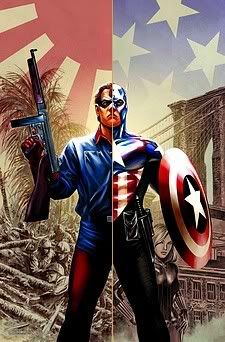 Speaking of tan, that leads me to Captain America #43, which has a nice light-brown cover (it looks way more tan in person than it does in that little picture). It’s the first issue of the post-Death of Captain America era, and it returns to the World War II era, which was common among some of my favorite issues in the early part of this new Captain America series. It’s all about showing this tougher, more soldier-like side of Bucky. But do not forget, for all his toughness, this man is a lover, and Black Widow proves it by walking around naked for most of this issue.
Speaking of tan, that leads me to Captain America #43, which has a nice light-brown cover (it looks way more tan in person than it does in that little picture). It’s the first issue of the post-Death of Captain America era, and it returns to the World War II era, which was common among some of my favorite issues in the early part of this new Captain America series. It’s all about showing this tougher, more soldier-like side of Bucky. But do not forget, for all his toughness, this man is a lover, and Black Widow proves it by walking around naked for most of this issue.
I’m rapidly losing steam when it comes to reviewing these things, but this series is so good that Captain America can fight a stupid French supervillain in purple pajamas and I still think it’s awesome.

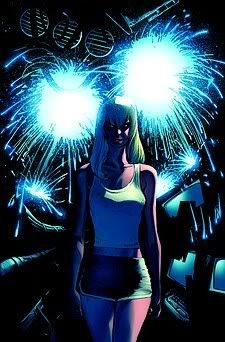 Speaking of purple pajamas, Ultimate Spider-Man #127 ends with the resurrected Gwen Stacy sitting on Peter Parker’s floor (in a lavender nightshirt, mind you) with Carnage’s face. Apparently she didn’t die after all, or at least maybe died but came back due to the healing properties of the symbiote.
Speaking of purple pajamas, Ultimate Spider-Man #127 ends with the resurrected Gwen Stacy sitting on Peter Parker’s floor (in a lavender nightshirt, mind you) with Carnage’s face. Apparently she didn’t die after all, or at least maybe died but came back due to the healing properties of the symbiote.
Ultimate Spider-Man is one of those books I’ve always enjoyed when I’ve read it, but it seems like so little happens in each issue. Sort of like with Invincible. I usually like them when I read them, but then I think “This was $2.99? I spent $2.99 on three minutes of reading?” I didn’t actually think that precisely in that way, since I got that issue for free from Doom DeLuise, but factor in that Marvel’s jacking up all their books to $3.99 soon, and there’s just no way I can justify it.
I don’t ever want to read this many comics in a week again. I don’t know how I used to do it. Maybe it wasn’t the reading that was so bad, but dear God, writing about all of it. Ugh.
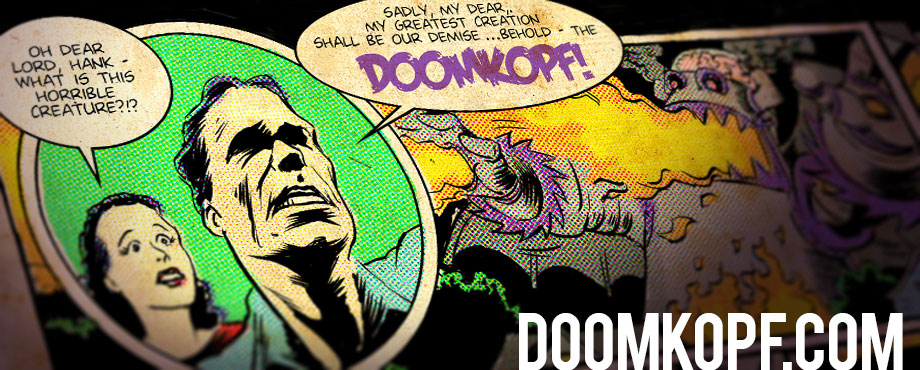
I never thought I’d read the segue, “Speaking of purple pajamas…”
[…] reveal ahead of schedule. Thus, many lazy writers use obfuscation to create mystery. But like Jim Doom says: The fact that I don’t know what the mystery is doesn’t make me more […]
I disagree, and found that to undermine the whole effort.
Why bother with a newspaper? Isn’t there like… a war going on or something? Shouldn’t they be making an effort to fight?
You probably say “the newspaper is their fighting effort” and I have to ask, “How?” Isn’t the whole “anti-life equation” one that robs you of your free will whether you want it to or not? What good does the paper do then? What would you think about someone continuing to put out a newspaper during a zombie movie? What good does it do? Are the zombies suddenly going to start reading it and decide to stop eating brains? Hell, they’re even using the ray to deliver them when he could be… I don’t know, fighting the enemy???
That’s what bugs me about Morrison’s whole take on Darksied in both this and Rock of Ages. He shows Darksied with this whole propaganda machine of “Die for Darksied etc” but… why? If the big lug has the anti-life equation (hate that name too) then he doesn’t need propaganda, everyone’s going to die for him anyway.
It seems that Grant Morrison can’t make up his mind sometimes and throws in mutually exclusive plot points and threads then yells at us for “not getting it” when we point out that out.
I imagine the newspaper is more a morale boost and source of information for those still in the fight, presumably produced by the people cowering in the background of the various stronghold shots who aren’t much good against superpowered anti-life soldiers. I actually don’t see the newspaper as being any kind of offensive tactic against those who have already succumbed.
Rather than equating this with the delivery of newspapers during a zombie movie, the more obvious correlation would be to equate it with the power of an underground press among resistance forces during political and military occupations. Ray was delivering papers, but he was also crucial to spreading the word about the resistance from one location to the other.
Possibly true Jim, but there’s more problems even with that.
For one thing, wouldn’t that rather endanger a lot of the underground forces? If the occupying power gets a hold of these papers, bam! they have a hardcopy evidence of the resistance and a possible method of tracking back to the cells.
Also, resistance fighters have a bit of a paradox in that you need to communicate with them (for morale and to coordinate large offensives) but you also need to keep the groups as separated as possible so when a fighter is captured, the location and information of other resistance cells can’t be tortured out of him/her. It makes you wonder why bother with a paper, just have the ray play messenger boy to everyone, maybe get Mr Terrific or someone to whip up a new communication device with a dedicated line (super walkie talkies!) to send to all the resistance cells. Maybe use some kyptonian tech laying around the fortress? (not like the bad guys will have updated drivers for it)
It wouldn’t surprise me if maybe Morrison is making some meta statement about old media vs new media, at which point we run into my rant about politics again, where the story is being hurt and wounded by efforts to make it “political” or “relevant”.
I think you’d have a better case if Morrison had invented the idea of underground media serving an important role in resistance forces, but he didn’t. So rather than inventing an illogical plot device, he’s merely calling on something that ties this fictional freedom struggle to real ones.
A good point Jim, but I still object to Morrison pulling “real world” plot devices into situations that have no true parallel in the real world.
It’s my same complaint about JLA 83, an issue that’s just one big political cartoon. The whole thing falls apart because Joe Kelly (I think was the writer) used things drawn from the “real world” that didn’t work at all within the DCU.
[…] reveal ahead of schedule. Thus, many lazy writers use obfuscation to create mystery. But like Jim Doom says: The fact that I don’t know what the mystery is doesn’t make me more […]